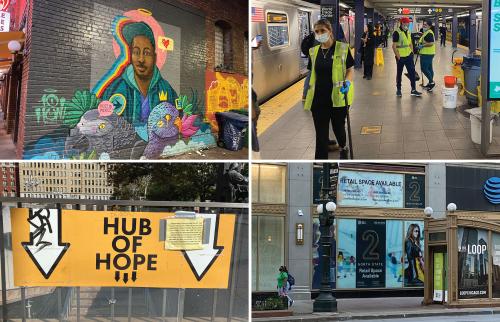Historically, residents of down-at-heel neighborhoods have been given little reason to love revitalization efforts. Too often, well intentioned renewal programs and investor-led development ended up forcing them from their homes. The challenges facing these neighborhoods, especially those with Black majority populations, are formidable, rooted in years of racially biased policies like redlining. A new approach to revitalization, community-led interventions in the housing market, reframes those challenges as opportunities and holds promise for developing larger, stronger, and more inclusive communities.
Hyper-vacancy and devaluation create cycle of displacement
Declining markets and unsafe neighborhoods often experience hyper-vacancy, an excessively high rate of unoccupied homes. In Baltimore, for example, roughly 15,000 residential properties across the city were unoccupied in 2022, a figure that has hovered between 7% and 8% of the housing stock for over a decade. In 2010, legacy cities—places like Detroit, Baltimore, and Cleveland, that have seen large population declines due to the loss of industrial jobs—also had high rates of hyper-vacancy. In Baltimore, for example, 29.5% of all census tracts were experiencing hyper-vacancy in 2010—a number that has increased from 7.5% in 1990.
The large number of vacant homes contributes to devaluation—when a property’s value is lower than its worth—and displacement, perpetuating cycles of disinvestment. In a 2018 Brookings study, researchers found that homes in predominantly Black neighborhoods across the country are valued 21% to 23% lower, on average, than similar homes in white neighborhoods that share the same socioeconomic demographics.
When devaluation is coupled with hyper-vacancy, the damage to neighborhoods increases. A reduction in the quality of neighborhood amenities, flight, social decline, and less investment lower property prices, attracting investors, and paving the way for gentrification that displaces low-income residents. This was the case, for example, in the Middle East neighborhood of Baltimore, where legacy residents moved out when more affluent residents moved in. What could otherwise have been a beneficial process of renewal instead excluded the original residents from affordable housing in what had been their own neighborhood.
Revitalizing communities can also be difficult at a more nuts-and-bolts level. With the proliferation of properties priced at less than their worth, investors find it harder to get proper financing: The cost of development is much higher than the disproportionately low value ascribed to the property. Some investors simply don’t see the point in investing in something that supposedly offers little in return. While different from the displacement caused by devaluation, this can also negatively impact low-income and legacy residents. Residents who stay put as their neighborhood continues to decline see their assets lose value and can become stranded in a blighted area.
Devaluation is the common element to both the displacement that occurs in gentrification and the erosion of assets that occurs when investors have no incentive to invest in a community. We must invest in people and solutions that facilitate local economic development without pushing out legacy residents.
Community-led solutions can interrupt cycles of devaluation
Projects like Parity, founded by former financial analyst Bree Jones, are pursuing these goals. Headquartered in West Baltimore, Parity acquires and rehabilitates abandoned properties by the block. The process fundamentally upends the traditional approach to home purchasing. The organization, run and operated by Baltimore residents, is a direct response to the city’s high rates of gentrification.
Jones witnessed the problem of development that provided few benefits to local communities in her hometown of New Rochelle, New York. In Baltimore, Jones focused on creating a more inclusive and locally representative development process, helping to lower the high costs that made acquisition and redevelopment of abandoned buildings difficult for legacy residents.
To accomplish this goal, Parity takes control of the development process, heavily involving neighborhood residents. This shifts the power structures away from extractive development, focused solely on profit generation, and into the hands of community members. The end result is the creation of an avenue for revitalization that didn’t exist before—one in which community members, otherwise priced out of the development process, have an opportunity to participate.
Similar innovations are happening in other U.S. cities that are facing the same challenges of hyper-vacancy and gentrification as Baltimore. The Fitzgerald Revitalization Project, is another example. Operated by the City of Detroit, the project is transforming 400 publicly owned vacant land and buildings into community assets, including park lands and recreation areas. The core concept of the project is to work in partnership with residents and local stakeholders to guide redevelopment efforts. Importantly, the project emphasizes civic assets, like parks, neighborhood centers, and locally owned businesses. Members of the local community have an active role in choosing how to revitalize these neighborhoods by helping to decide where and what types of infrastructure and businesses to invest in.
Other organizations, like The Works, are pursuing a slightly different strategy to combat gentrification—leveraging existing community assets to create a more economically diverse and robust neighborhood. The Memphis organization uses a mix of tools to subsidize the cost of home ownership in Klondike, a historic Black-majority neighborhood, to help keep the neighborhood affordable. Among these tools are a shared-equity model, in which the not-for-profit shares some of the equity generated as the home appreciates in value to subsidize lower prices to community members while still offering some homes to more affluent buyers. Through this approach, The Works is helping to develop mixed-income properties that can better spread the benefits of neighborhood development across income groups. In contrast to the usual approach to neighborhood revitalization, The Works is guided by three “non-negotiables” in its efforts to balance growing neighborhood wealth with enabling access for lower income residents: Zero displacement, permanent affordability, and the creation of homeowner wealth through rising home values, for those who can afford to buy without shared equity.
Hyper-vacancy and devaluation can be an opportunity for community-led renewal
To address the pervasive effects of devaluation and racism, policymakers must prioritize initiatives that promote fair housing practices across income levels, including the absence of racial discrimination, and investment strategies which advance access to the benefits that can come with living in an area that is seeing investment. By supporting community-led organizations and implementing anti-discrimination measures, governments can mitigate the harmful consequences of structural racism and foster vibrant, resilient neighborhoods for all residents.
Hyper-vacancy and devaluation can be more than symptoms of economic decline—they can be opportunities for community-led renewal and empowerment. By reframing these challenges as catalysts for change, we can dismantle systemic barriers and create more equitable housing markets. Through collaborative efforts and targeted policy interventions, we can build resilient neighborhoods that reflect the diversity and vibrancy of our communities. It’s time to invest in these people and places and ensure that the promise of the American dream is accessible to all.





